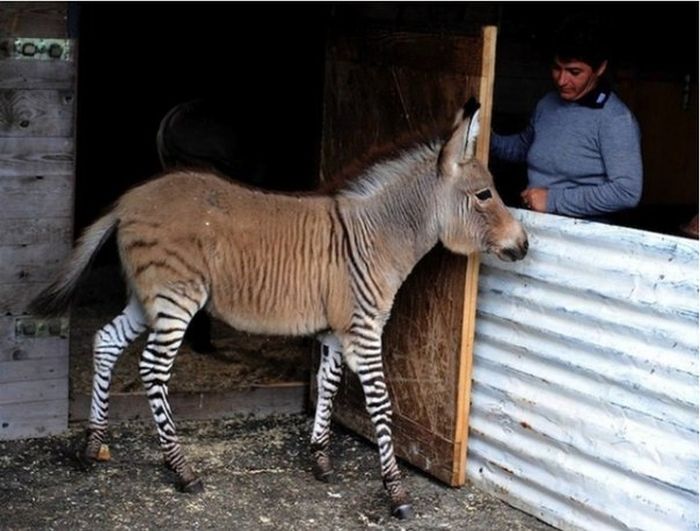|
|
Zonkey, Zebra Donkey Hybrid
|
In 1815, Lord Morton mated a quagga stallion to a chestnut Arabian mare. The result was a female hybrid which resembled both parents. This provoked the interest of Cossar Ewart, Professor of Natural History at Edinburgh (1882–1927) and a keen geneticist. Ewart crossed a zebra stallion with pony mares to investigate the theory of telegony, or paternal impression. In Origin of Species (1859), Charles Darwin mentioned four coloured drawings of hybrids between the ass and zebra. He also wrote "In Lord Morton's famous hybrid from a chestnut mare and male quagga, the hybrid, and even the pure offspring subsequently produced from the mare by a black Arabian sire, were much more plainly barred across the legs than is even the pure quagga." In his book The Variation of Animals and Plants under Domestication, Darwin described a hybrid ass-zebra specimen in the British Museum as being dappled on its flanks. He also mentioned a "triple hybrid, from a bay mare, by a hybrid from a male ass and female zebra" displayed at London Zoo. This would have required the zebroid sire to be fertile.
During the South African War, the Boers crossed the Chapman's zebra with the pony, to produce an animal for transport work, chiefly for hauling guns. A specimen was captured by British forces and presented to King Edward VII by Lord Kitchener, and was photographed by W S Berridge. Zebras are resistant to sleeping sickness, whereas purebred horses and ponies are not, and it was hoped that the zebra mules would inherit this resistance.
Grevy's zebra has been crossed with the Somali ass in the early 20th century. Zorses were bred by the US Government and reported in Genetics in Relation to Agriculture by E. B. Babcock and R. E. Clausen (early 20th century), in an attempt to investigate inheritance and telegony. The experiments were also reported in The Science of Life by H G Wells, J Huxley and G P Wells (c. 1929).
The 1970s continued the interest in zebra crosses. A New York Times article from 16 June 1973 mentioned the birth of a cross between a zebra and a donkey at the Jerusalem Zoo. They called it a "hamzab." In the 1970s, the Colchester Zoo in England bred zedonks, at first by accident and later to create a disease-resistant riding and draft animal. The experiment was discontinued when zoos became more conservation-minded. A number of hybrids were kept at the zoo after this; the last died in 2009. One adult and a foal remain at the tourist attraction of Groombridge Place near Tonbridge in Kent.
|
|









